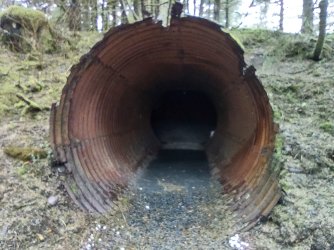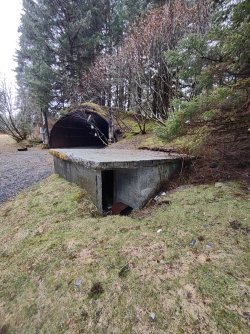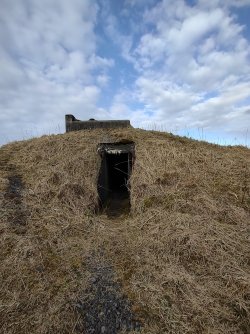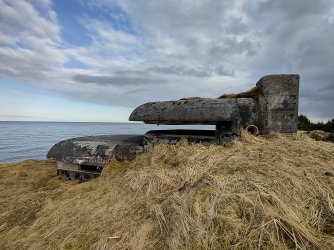testtest
You are using an out of date browser. It may not display this or other websites correctly.
You should upgrade or use an alternative browser.
You should upgrade or use an alternative browser.
WW2 Gun Inplacement's
- Thread starter Kodiak Cowboy
- Start date
Recusant
Hellcat
Has anyone you know tried hunting the area with a metal detector?These are old five inch gun inplacement in a different neighbors yards just a few hundred yards down the road. As you can see. One has been protected with a concrete retaining wall after the state road was moved back from the ocean cliff due to erosion. These WW2 monuments are protected. Not even the property owner can remove them.
Kodiak Cowboy
Custom
Yes actually, people have! Many folks have found old WW2 artifacts. One still commonly found is steel bremel steaks (defensive barb wire fence posts). I've lined my driveway with these posts. Along with some other neighbors. Some still have little pieces of barb wire still attached from over 75 years ago! Also found can be old small arms, casings and even anti ship casings and projectiles that were left over and never fired from some of all the different caliber gun inplacements! 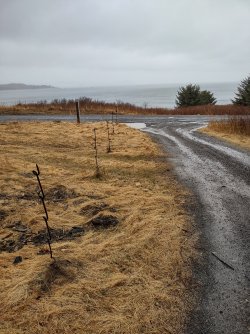
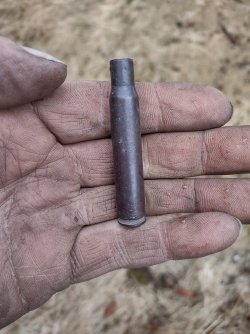
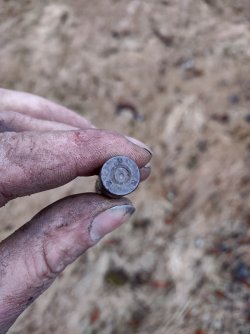
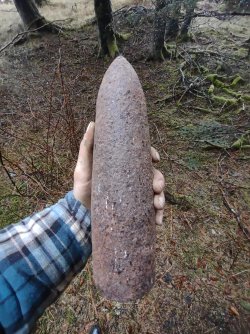
I've been lucky enough to find a few 06 casings myself. Probably fired from a M1 garand, 1903, or possibly even a BAR! My coolest find was a 3.5 inch projectile chamberd in one of the many 3.5 inch inplacement's!




I've been lucky enough to find a few 06 casings myself. Probably fired from a M1 garand, 1903, or possibly even a BAR! My coolest find was a 3.5 inch projectile chamberd in one of the many 3.5 inch inplacement's!
Kodiak Cowboy
Custom
A true testament to American Steel! These barbwire posts are still standing strong along some of the beaches and cliffs on the shores of Kodiak Island. 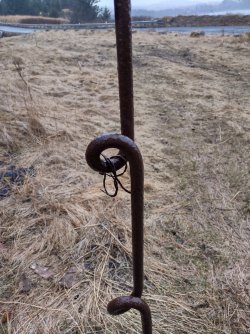
It's not the size of the flag that flys. It's the size of the fly in the flag! And no flag flys higher, brighter, stronger, or prouder. Than the flag of the United States of America! God bless this great country and our right as American citizens to keep and bare arms!
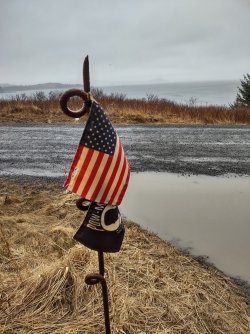
Stand by for more posts and pics coming in the near future of the big 8" gun inplacement's, pill boxes, sentry bunkers, and big fortified concrete munitions bunkers!

It's not the size of the flag that flys. It's the size of the fly in the flag! And no flag flys higher, brighter, stronger, or prouder. Than the flag of the United States of America! God bless this great country and our right as American citizens to keep and bare arms!

Stand by for more posts and pics coming in the near future of the big 8" gun inplacement's, pill boxes, sentry bunkers, and big fortified concrete munitions bunkers!
Last edited:
Recusant
Hellcat
As an old relic hunter, I can really appreciate the shell you dug up. Most of the time one doesn't find items that justify the time spent or cost of a good metal detector, but it can be a rewarding hobby. Those steel bremel steaks were designed during WWI by the Brits. At night a man could crawl out into no man's land and quietly screw the steak into the ground by putting a wooden rod through the loops to turn it. Who knows, yours could have been left-over WWI stock. Just so folks know, the gunboat shell was drilled, and the loose powder removed to render it safe. Federal gunboats shelled an area east of Richmond during the Seven Day's campaign.

Kodiak Cowboy
Custom
Yes! Can be quite good artifact hunting with metal detectors! Although, over the years. A lot of people have cheery picked the cream of the crop in most areas. People are still finding old WW2 artifacts! I'm pretty sure it is legal to keep what you find too. I haven't heard otherwise and don't know anyone that has been stopped or sighted for WW2 artifact hunting. However, hunting, digging, and the possession or removal of old ancient Alaskan native artifacts from ancient native "sites" is illegal.Has anyone you know tried hunting the area with a metal detector?
Kodiak Cowboy
Custom
Awesome! Very cool! As I stated earlier. I have my driveway lined with these bremel steaks. I drove rebar into the ground and set the "cork screw" base of the posts on the rebar steaks so the can easily be moved if I have to. Removing them from their original positions did take a wooden or steel rod. With a little muscle and a lot of finesse. They unscrew right out of the ground. Unless a root has grown around them. Then it can be much more difficult. There was no American military presence on Kodiak Island during the first WW so all the military artifacts found on Kodiak are from WW2. However the bremel steaks may have been left over stock that the military saved from WW1 and used up here and many other places during the war as well. I'm not exactly sure though.As an old relic hunter, I can really appreciate the shell you dug up. Most of the time one doesn't find items that justify the time spent or cost of a good metal detector, but it can be a rewarding hobby. Those steel bremel steaks were designed during WWI by the Brits. At night a man could crawl out into no man's land and quietly screw the steak into the ground by putting a wooden rod through the loops to turn it. Who knows, yours could have been left-over WWI stock. Just so folks know, the gunboat shell was drilled, and the loose powder removed to render it safe. Federal gunboats shelled an area east of Richmond during the Seven Day's campaign.
View attachment 26478
Last edited:
Oh the replenishment project was shortly after hurricane Sandy. So the shells were about 100 years old.During beach replenishment at the NJ shore they would pump sand from offshore to the beach. Well, after WWI the army dumped countless numbers if shells just off the coast. So during the replenishment people would were finding artillery shells in the beach!
Kodiak Cowboy
Custom
I'm assuming the stamp on these casings represents the Ammo maker and year produced, but I'm not exactly sure about that. If so, In this case (no pun intended). This casing is from ammo probably produced by Union Metallic Cartridge Co. In 1942, but don't quote me on that!As an old relic hunter, I can really appreciate the shell you dug up. Most of the time one doesn't find items that justify the time spent or cost of a good metal detector, but it can be a rewarding hobby. Those steel bremel steaks were designed during WWI by the Brits. At night a man could crawl out into no man's land and quietly screw the steak into the ground by putting a wooden rod through the loops to turn it. Who knows, yours could have been left-over WWI stock. Just so folks know, the gunboat shell was drilled, and the loose powder removed to render it safe. Federal gunboats shelled an area east of Richmond during the Seven Day's campaign.
View attachment 26478
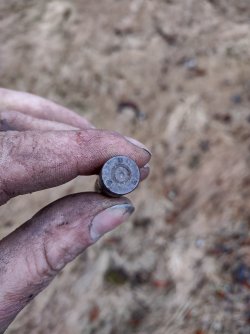
Kodiak Cowboy
Custom
Roger, lots of munitions have been found on the beaches here as well. It's quite interesting the money spent just on the destruction of heavy arms and disposal of thier munitions at the end of the war in my opinion!During beach replenishment at the NJ shore they would pump sand from offshore to the beach. Well, after WWI the army dumped countless numbers if shells just off the coast. So during the replenishment people would were finding artillery shells in the beach!
Recusant
Hellcat
I'm assuming the stamp on these casings represents the Ammo maker and year produced, but I'm not exactly sure about that. If so, In this case (no pun intended). This casing is from ammo probably produced by Union Metallic Cartridge Co. In 1942, but don't quote me on that!View attachment 26482
- U or UT Utah Ordnance Plant (March 1942 to December 1943) – Salt Lake City; a division of Remington Arms.
Kodiak Cowboy
Custom
Very cool! Solid info Recusant. Thank you for making that clear. Now I know instead is assuming. Because when I assume. It just makes an *** out of "u" "m" "e"


Recusant
Hellcat
There's at least 150 years of shell casings buried in the ground from sea to shining sea. A guide helps, but it probably does not cover everything. For me, it's been shotgun shell heads. I've dug up hundreds.Very cool! Solid info Recusant. Thank you for making that clear. Now I know instead is assuming. Because when I assume. It just makes an *** out of "u" "m" "e"
Keystone19250
SAINT
Very cool.These are old five inch gun inplacement in a different neighbors yards just a few hundred yards down the road. As you can see. One has been protected with a concrete retaining wall after the state road was moved back from the ocean cliff due to erosion. These WW2 monuments are protected. Not even the property owner can remove them.
Kodiak Cowboy
Custom
The weather was beautiful yesterday so I jumped on my off road weapon and rode up to Bunker Hill and out to the Cape for some more WW2 monument photos. This series of pics is one of two eight inch gun turrets and a couple sections of the gun's breach's after the guns were destroyed. To give an idea on size. The flooded section of the inplacement is about 24 feet across. Notice the cracks in the breach's. Some of that steel is over four inches thick! You can also see the lanez and groves from the 8 inch bore in the one section of the breach!
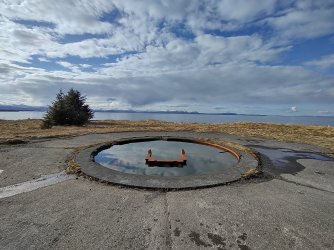





The Night Rider
Professional
As long as we're on this topic let's not forget that the Alaskan Territorial Guard (AKA the Irregular CIVILIAN MILITIA) Served in combat during the Japanese invasion of the Aleutian Islands.
Kodiak Cowboy
Custom
Yes! Also, Alaska was a territory during the war, and that's why you hear people say the US has never been invaded, but you are correct sir. The Aleutian Islands of Alaska was invaded by the Japanese! I believe they took Attu and Kiska Islands from us, but I may be wrong. I should know these facts though!
Recusant
Hellcat
If I lived there much of that stuff would find a new home in my garage! At least until my wife would have made get rid of it. There are not many places one can still find items from American history laying around. Here's an interesting story about Japan's occupation the islands of Attu and Kiska.


